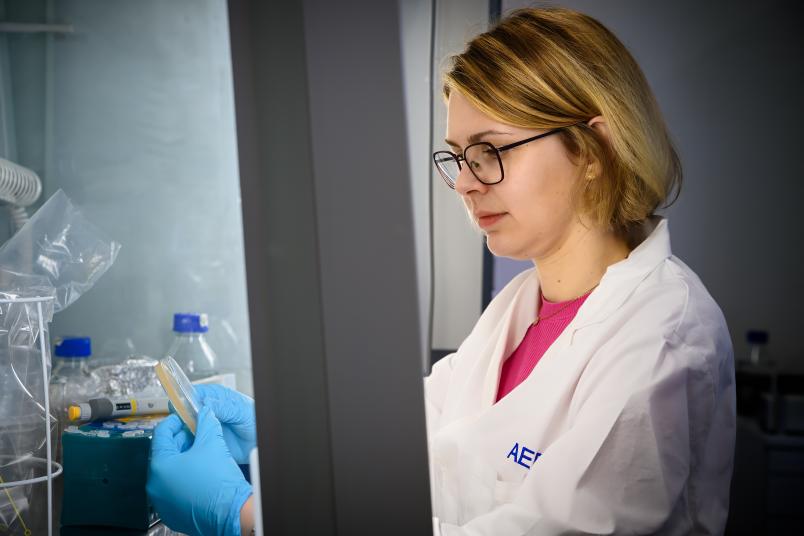
Plasma research
Purple Discharges on the Skin
Cold plasma has an antimicrobial and anti-inflammatory effect. This has been demonstrated in studies at Ruhr University Bochum. Promising applications in medicine and cosmetics are now emerging.
Fine purple gas dirscharges flicker like thousands of tiny flashes in the darkness of the lab. A soft crackle. The discharges are generated inside a 12-by-12-centimeter plasma reactor. Each flash lasts for only a few microseconds and a bunch of new ones are constantly generated. „This is partially ionized plasma. Most people are familiar with this fascinating phenomenon from auroras, which are simply gaseous plasma,” says Dr. Friederike Kogelheide from the Chair of Applied Electrodynamics and Plasma Technology at Ruhr University Bochum. “Plasma can be described as the fourth state of matter, in addition to solid, liquid and gaseous. There is thermal and non-thermal, i.e. cold plasma,” continues Kogelheide. Kogelheide researched the latter in her doctoral thesis in electrical engineering. It’s characterized by an extremely low temperature – at least in comparison to other plasmas, which can reach temperatures of several thousand degrees Celsius. “Cold plasma is approximately the same as our body temperature, i.e. just over 30 degrees Celsius, and is therefore not harmful to the skin,” explains Kogelheide. She has conducted extensive research into the influence of cold plasma on human skin cells, or more precisely, its antimicrobial effect. Her research findings have been incorporated into her start-up Glim Skin.

For approximately ten years, researchers in biology, chemistry, physics, medicine and electrical engineering have been exploring the use of cold plasma in medical applications. There are high hopes for this technology, especially in the field of wound care and healing. “Studies have already shown that molecules produced by plasma, such as nitric oxide, can accelerate wound healing. The beneficial effect of cold plasma is also attributed to the ozone concentration and UV radiation in the plasma,” explains Kogelheide. Another advantage of cold plasma is that it corresponds to our body temperature and can therefore be applied to human skin both painlessly and without physical contact. This is why plasma research is regarded as highly promising.
Fighting resistant bacteria
In order to study the antimicrobial effect of cold plasma, the interdisciplinary research team in Bochum headed by Kogelheide experimented with spores. “We mainly investigated the effect of plasma on so-called Bacillus subtilis spores. These bacteria are known to be particularly resistant; they can even survive in permafrost. They are therefore considered the gold standard in sterilization experiments,” explains Kogelheide. The aim of the researchers was to specifically reduce and completely eradicate the spores using cold plasma.

We proceeded step by step.
“We proceeded step by step,” says Kogelheide. “Our main focus was on the biological substances and components produced by the cold plasma, such as UV radiation, ozone concentration and nitric oxide. How much of these substances does our plasma produce? Do
the spores continue to grow after being treated with plasma? What dose is required to destroy the spores? And which part does the ozone play in these processes?” Kogelheide’s team repeatedly checked and changed the composition of the gas mixture, the treatment time and intensity. Measurements were taken using emission and absorption spectroscopy.
The results show: It wasn’t the individual components, but rather the combination of ozone, UV radiation and nitric oxide that inactivated the spores. “On their own, the individual components had much less effect. This is because the substances form a synergy. Another interesting discovery was that a natural humidity of around 45 percent relative humidity promoted inactivation,” explains Kogelheide.
Lower risk of infection
With their findings, the Bochum researchers have once again proved that cold plasma has an antimicrobial effect. They also confirmed that plasma produces nitric oxide, which can help seal wounds. “If we could replace wound healing creams with plasma treatment some time soon, that would be a huge step forward,” points out Kogelheide. This is because cold plasma can be applied without physical contact. “Unlike creams, plasma applications significantly reduce the risk of infection,” explains the researcher.
Plasma in the hospital
Anti-inflammatory, wound-healing, antimicrobial: Even though plasma research is still in its infancy, promising areas of application are already emerging. “Companies are already waiting in the wings to invest capital in the approval of plasma-based medical products by health insurance companies,” notes Kogelheide. At some point, it may be commonplace for the purple plasma flashes to flicker through every hospital.



